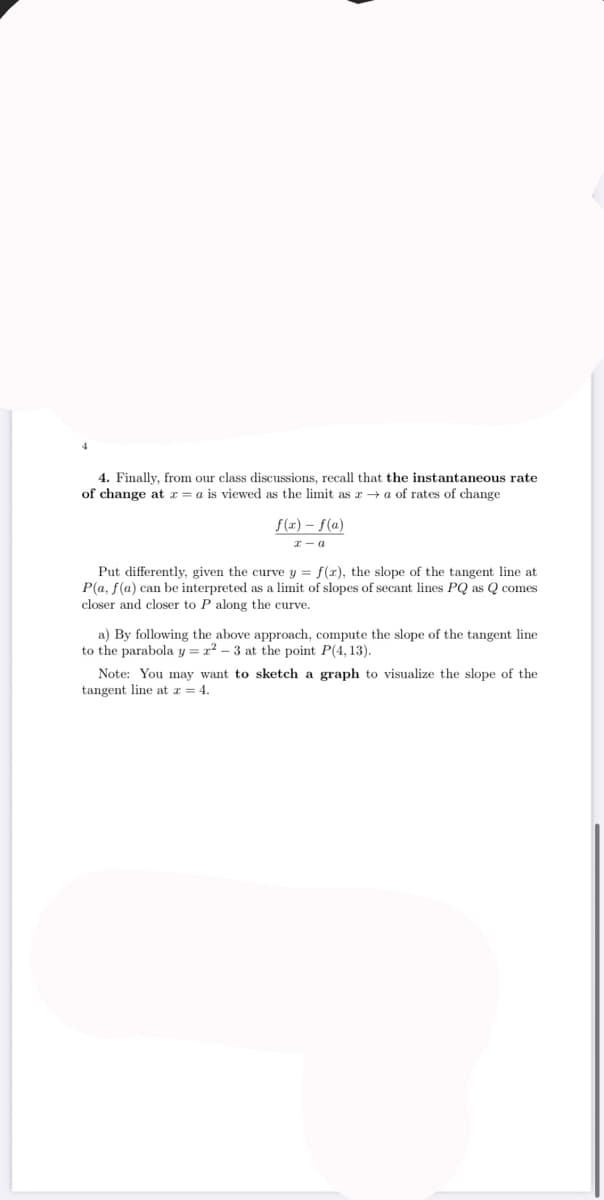4. Finally, from our class discussions, recall that the instantaneous rate of change at r = a is viewed as the limit as aa of rates of change S(z) – f(a) Put differently, given the curve y f (x), the slope of the tangent line at P(a, f(a) can be interpreted as a limit of slopes of secant lines PQ as Q comes closer and closer to P along the curve. a) By following the above approach, compute the slope of the tangent line to the parabola y = x2 - 3 at the point P(4, 13). Note: You may want to sketch a graph to visualize the slope of the tangent line at a = 4.
4. Finally, from our class discussions, recall that the instantaneous rate of change at r = a is viewed as the limit as aa of rates of change S(z) – f(a) Put differently, given the curve y f (x), the slope of the tangent line at P(a, f(a) can be interpreted as a limit of slopes of secant lines PQ as Q comes closer and closer to P along the curve. a) By following the above approach, compute the slope of the tangent line to the parabola y = x2 - 3 at the point P(4, 13). Note: You may want to sketch a graph to visualize the slope of the tangent line at a = 4.
Calculus: Early Transcendentals
8th Edition
ISBN:9781285741550
Author:James Stewart
Publisher:James Stewart
Chapter1: Functions And Models
Section: Chapter Questions
Problem 1RCC: (a) What is a function? What are its domain and range? (b) What is the graph of a function? (c) How...
Related questions
Question
100%

Transcribed Image Text:4. Finally, from our class discussions, recall that the instantaneous rate
of change at r = a is viewed as the limit as r → a of rates of change
f(x) – f(a)
I - a
Put differently, given the curve y = f(x), the slope of the tangent line at
P(a, f(a) can be interpreted as a limit of slopes of secant lines PQ as Q comes
closer and closer to P along the curve.
a) By following the above approach, compute the slope of the tangent line
to the parabola y = x? – 3 at the point P(4, 13).
Note: You may want to sketch a graph to visualize the slope of the
tangent line at z = 4.
Expert Solution
This question has been solved!
Explore an expertly crafted, step-by-step solution for a thorough understanding of key concepts.
Step by step
Solved in 2 steps with 1 images

Knowledge Booster
Learn more about
Need a deep-dive on the concept behind this application? Look no further. Learn more about this topic, calculus and related others by exploring similar questions and additional content below.Recommended textbooks for you

Calculus: Early Transcendentals
Calculus
ISBN:
9781285741550
Author:
James Stewart
Publisher:
Cengage Learning

Thomas' Calculus (14th Edition)
Calculus
ISBN:
9780134438986
Author:
Joel R. Hass, Christopher E. Heil, Maurice D. Weir
Publisher:
PEARSON

Calculus: Early Transcendentals (3rd Edition)
Calculus
ISBN:
9780134763644
Author:
William L. Briggs, Lyle Cochran, Bernard Gillett, Eric Schulz
Publisher:
PEARSON

Calculus: Early Transcendentals
Calculus
ISBN:
9781285741550
Author:
James Stewart
Publisher:
Cengage Learning

Thomas' Calculus (14th Edition)
Calculus
ISBN:
9780134438986
Author:
Joel R. Hass, Christopher E. Heil, Maurice D. Weir
Publisher:
PEARSON

Calculus: Early Transcendentals (3rd Edition)
Calculus
ISBN:
9780134763644
Author:
William L. Briggs, Lyle Cochran, Bernard Gillett, Eric Schulz
Publisher:
PEARSON

Calculus: Early Transcendentals
Calculus
ISBN:
9781319050740
Author:
Jon Rogawski, Colin Adams, Robert Franzosa
Publisher:
W. H. Freeman


Calculus: Early Transcendental Functions
Calculus
ISBN:
9781337552516
Author:
Ron Larson, Bruce H. Edwards
Publisher:
Cengage Learning